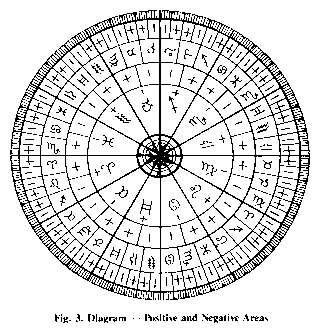The Vedic Divisional Chart used in Western Astrology
© 2001 Andrea Malvagna
In this article I will speak about the vedic divisional chart used in western astrology: the decanates and the terms or boundaries and the faces.
The divisional charts or vargas in vedic astrology are widely used for the natal chart interpretation to give more details about houses meanings, the group of divisional chart used in Parashara the most popular vedic astrology is called "Shodashavarga" 16 divisional chart, there are different groups of divisional chart according the schools, but all the vedic astrologers draw almost one divisional chart Navamsa or 9th divisional chart.
The 3rd divisional chart called drekkana is used to give more details about 3rd house meanings, as the others divisional charts has a sequence of rulership, the sign is divided in 3 equal parts, the first decanate is ruled by the same planet of the whole sign, the second division by the planet ruling the second sign of the same element and the third division by the planey that has rulership in the other sign of the same element.
Every decanate is divided in two parts, the 6th divisional chart is called Shastamsa, this is a varga used in another kind of vedic astrology Tajaka and is used in medical astrology, this divisional chart in western astrology is called by Alan Leo faces of decanate, in the figure at the end of article is possible to see in the 2th divisional chart, the faces of the signs called in vedic astrology Hora, the 36 decanates and the 72 faces of decanates. In the quoted text by Alan Leo is possible to find a kind of interpretation of the 72 faces.
In western astrology are also used others system of decanates; the Manilius system, the chaldean system and others system, in the Manilius system the decanates follow in the arrangement of the signs, in the Chaldean system the planets are arranged in ascending order from the slowest to the most rapid in orbital motion, all these systems start with Mars rulership of the first Aries decanate, In the quoted text by S.J. Ennis is possible to read an interesting comparision between the systems above, of course the system may be used for different levels of interpretation, thus like S.J. Ennis I prefer the oriental system.
The 30th divisional chart in vedic astrology called trimshamsa in western astrology is called terms or boundaries, in the vedic astrology is the only divisional chart with not equal division, like in the Egyptian and the Ptolemaic terms are used only five planets, there aren't division ruled by the Moon or the Sun, Mars Venus and Saturn rules 5 degrees in their diurnal and in the nocturnal sign, Mercury rules 7 degrees and Jupiter 8 degrees, the sequence of rulership for the positive signs is:
Mars-Saturn-Jupiter-Mercury-Venus;
Venus-Mercury-Jupiter-Saturn-Mars for the negative signs.
If we compare the oriental terms with Egyptian and Ptolemaic terms we found that The Taurus has the same order in all the systems, the others signs have the terms mixed, with numbers of degrees of rulership different, of course is possible to use the systems for different types of interpretation, in the article Death at G8 summit I have used the direction of ascendent in oblique ascension using Egyptian terms.
In others articles I will speak about the others divisional charts in vedic astrology starting of course from the most important divisional chart Navamsa.
Any exchange of point of view in this matter is appreciated. My e-mail is koppejan@inwind.it

QUOTED TEXTS:
James T. Braha, Ancient Hindu Astrology for the Modern Western Astrology
David Frawley, Astrology of Seers, Passage Press 1990
Bernice P.Grebner, Decanates a full view, A.F.A. 1990
Stephanie J.Ennis, Decanates and dwads, A.F.A 1983
Thyrza Escobar, The 144 doors of the zodiac the dwad technique, A.F.A 1986
Swami Mahachandra, Manual of vedic astrology
Alan Leo, Practical astrology being a simple method of instruction in the science of astrology, London 1910

